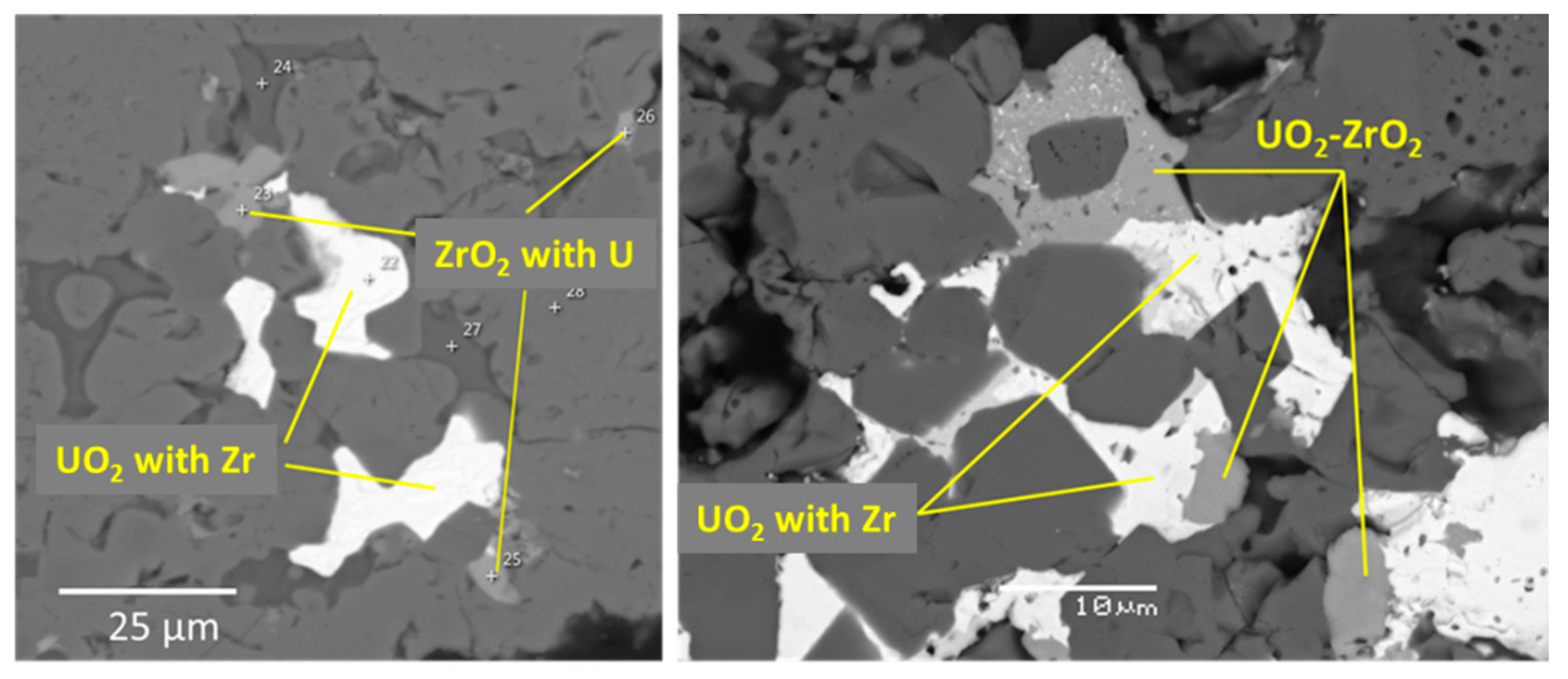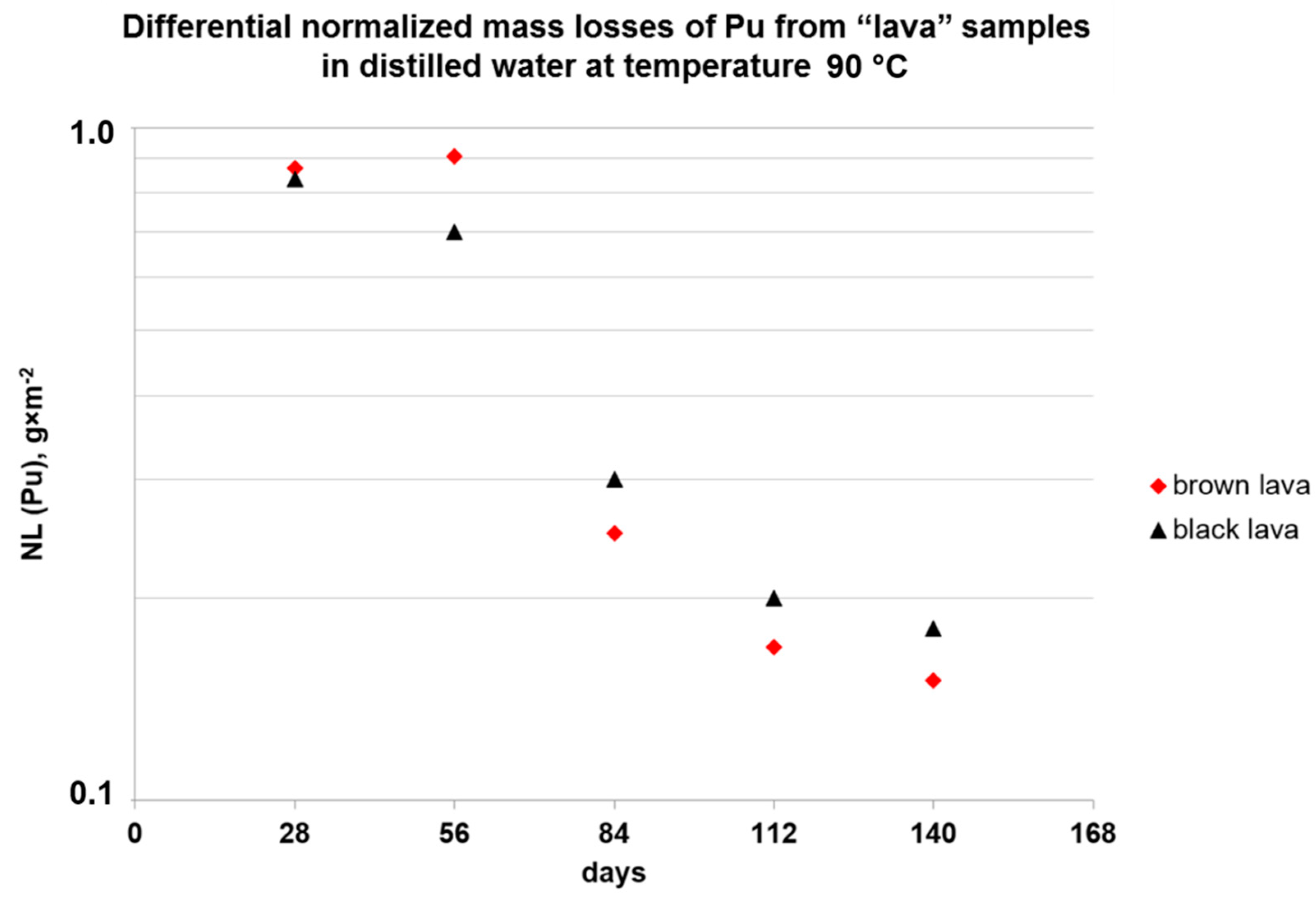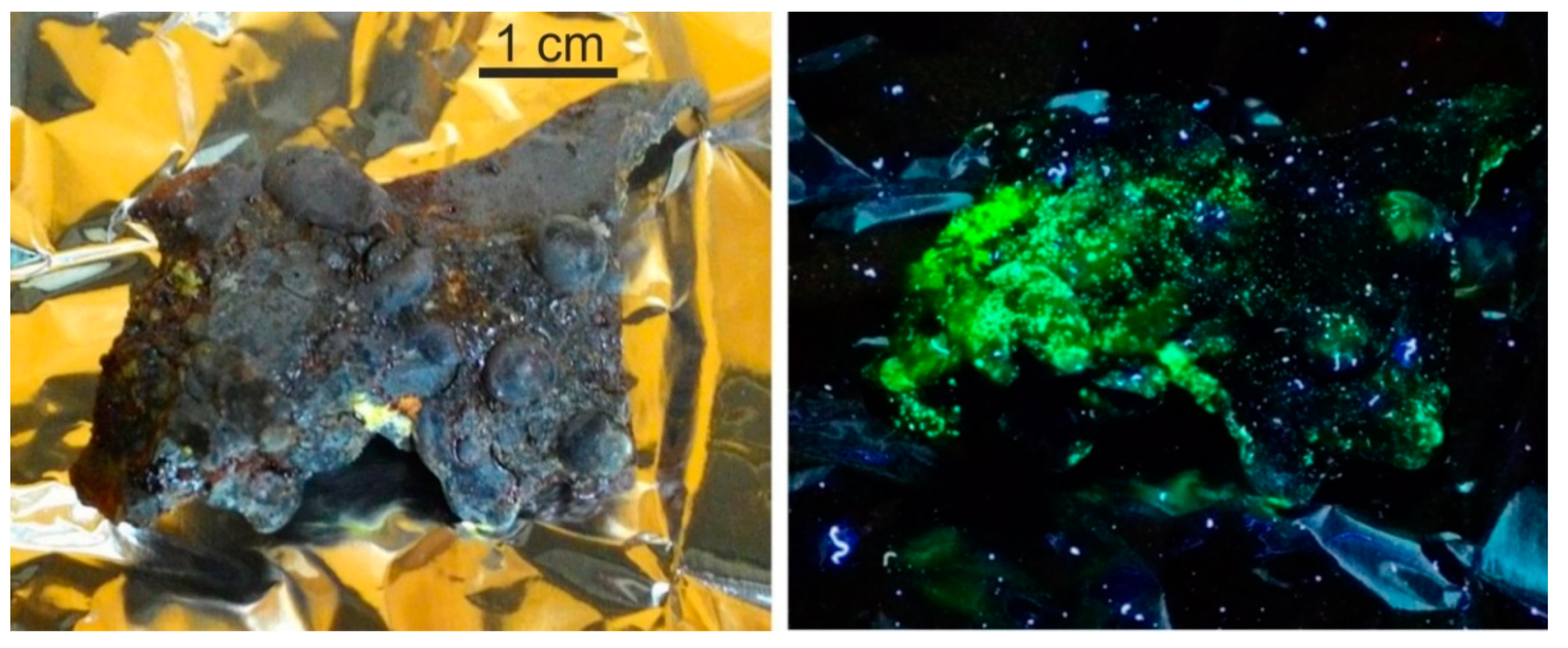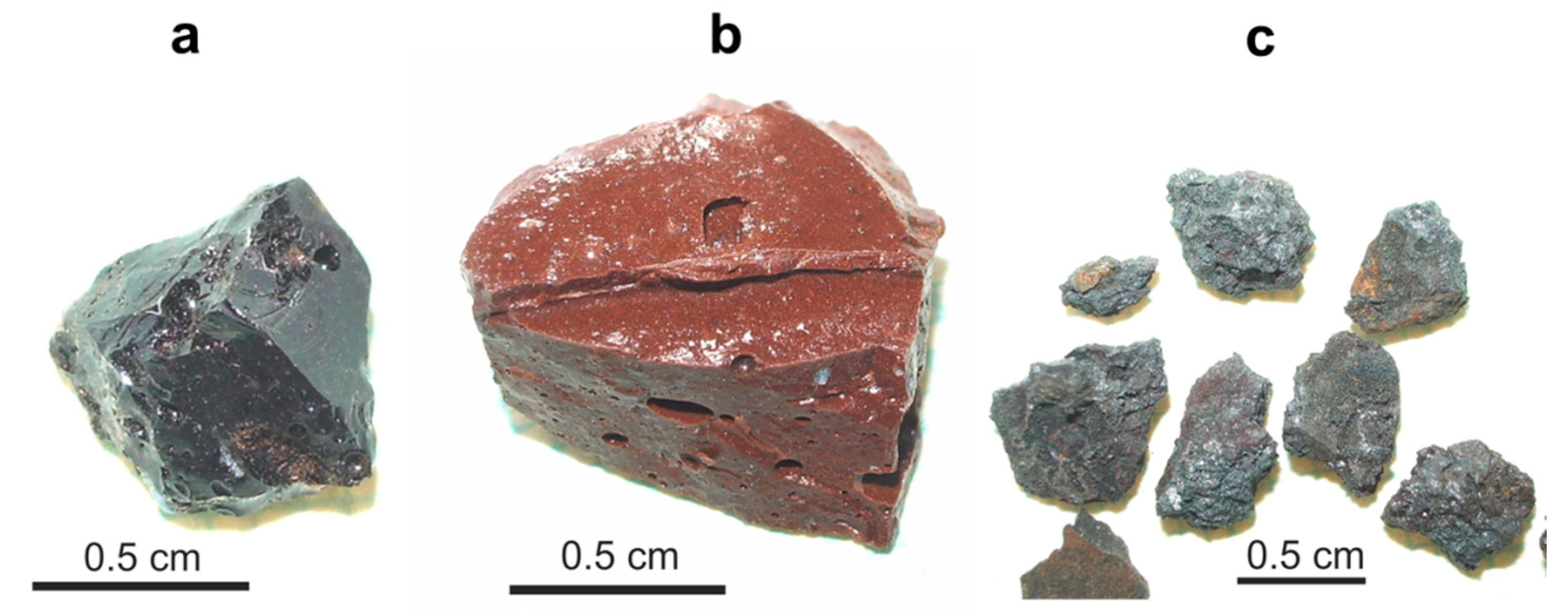Long-Term Aging of Chernobyl Fuel Debris: Corium and “Lava”
Abstract
:1. Introduction
2. Materials and Methods
- (1)
- A total of 3 fragments of corium from room 305/2—for leaching experiments at 25 and 90 °C and for alteration experiments at 150 °C in distilled water. Chemically, Chernobyl massive corium is very inhomogeneous [11]. The plutonium (238,239,240Pu) content in massive corium samples used for leaching tests varies from 1.4 to 5.6 MBq/g.
- (2)
- Two fragments of black “lava” and Two fragments of brown “lava”—for leaching at 90 °C and alteration at 150 °C in distilled water. Distribution of U and other alpha-emitters in matrices of Chernobyl “lava” (both black and brown) is relatively homogeneous [12]. Bulk content of plutonium (238,239,240Pu) in “lava” matrices is 1.5 and 3 MBq/g for black and brown “lava”, respectively [6,7,13,14].
- -
- Matrix consists of an iron oxide phase doped with Al и Cr (from 1 to 13 wt. % of Al and from 1 to 15 wt. % of Cr). This phase was identified by Raman spectroscopy and XRD analysis as Fe3O4 (PDF #011111). Different contents of Cr in the iron oxide phase affects the different levels of contrast in the BSE pictures.
- -
- Minor phases of solid solutions “UO2-ZrO2” (Figure 2) with the following compositions:
- (1)
- Zr-U-O with 50–60 wt. % of Zr and 13–20 wt. % of U;
- (2)
- mainly U-oxide phase with admixtures of Zr (1–2 wt. %) and Fe (1–3 wt. %);
- (3)
- mainly Zr-oxide phase with admixtures of U (1.5–3 wt. %) and Fe (3–10 wt. %).
3. Results
4. Discussion
- Pu release into distilled water from matrices of black and brown Chernobyl “lava” is comparable. The total normalized Pu mass loss at 90 °C is 2.2–2.3 g/m2 for 140 days.
- Pu release from matrix of Chernobyl corium is less than that from “lava”. The total normalized Pu mass loss for 140 days is 0.5 and 1.1 g/m2 at a temperature of 25 °C and 90 °C, respectively.
- In comparison with the irradiated U-oxide LWR fuel, Chernobyl corium demonstrates, essentially, a lower level of chemical durability. Normalized Pu mass loss in distilled water at 25 °C for spent fuel and even 239PuO2 is two orders of magnitude less than that for corium. It is assumed that at least part of the uranium and plutonium in the matrix of Chernobyl corium exist in chemically unstable forms.
- The chemical alteration of Chernobyl corium and “lava” causes the formation of new formed phases with essentially different chemical and mechanical levels of durability. This has consequential effects on the long-term behavior of fuel debris.
Author Contributions
Funding
Institutional Review Board Statement
Informed Consent Statement
Data Availability Statement
Acknowledgments
Conflicts of Interest
References
- Information on the accident at the Chernobyl nuclear power plant and its consequences. Sov. At. Energy 1986, 61, 845–868. [CrossRef]
- Rippon, S.; Blake, E.M.; Payne, J. Chernobyl: The Soviet Report. Nucl. News 1986, 29, 59–66. [Google Scholar]
- International Atomic Energy Agency. INSAG-7: The Chernobyl Accident: Updating of INSAG-1; Safety Series No. 75-INSAG-7; IAEA: Vienna, Austria, 1992. [Google Scholar]
- Poml, P.; Burakov, B. Study of a “hot” particle with a matrix of U-bearing metallic Zr: Clue to supercriticality during the Chernobyl nuclear accident. J. Nucl. Mater. 2017, 488, 314–318. [Google Scholar] [CrossRef]
- Burakov, B.E.; Anderson, E.B.; Galkin, B.Y.; Pazukhin, E.M.; Shabalev, S.I. Study of Chernobyl “hot” particles and fuel containing masses: Implications for reconstruction the initial phase of the accident. Radiochim. Acta 1994, 65, 199–202. [Google Scholar] [CrossRef]
- Burakov, B.E.; Anderson, E.B.; Shabalev, S.I.; Strykanova, E.E.; Ushakov, S.V.; Trotabas, M.; Blanc, J.-Y.; Winter, P.; Duco, J. The Behaviour of Nuclear Fuel in First Days of the Chernobyl Accident. MRS Online Proc. Libr. 1997, 465, 1297–1308. [Google Scholar] [CrossRef]
- Burakov, B.E. Lava-like materials formed and solidified during Chernobyl accident. In Comprehensive Nuclear Materials, 2nd ed.; Konings, R., Stoller, R.E., Eds.; Elsevier: Amsterdam, The Netherlands, 2019. [Google Scholar]
- Konoplev, A.V.; Bulgakov, A.A. Kinetics of 90Sr leaching from fuel particles in soils of the Chernobyl exclusion zone. At. Energy 1999, 86, 136–141. [Google Scholar] [CrossRef]
- Bulgakov, A.; Konoplev, A.; Smith, J.; Laptev, G.; Voitsekhovich, O. Fuel particles in the Chernobyl cooling pond: Current state and prediction for remediation options. Environ. Radioact. 2009, 100, 329–332. [Google Scholar] [CrossRef]
- Malkovsky, V.I.; Yudintsev, S.V.; Ojovan, M.I.; Petrov, V.A. The Influence of Radiation on Confinement Properties of Nuclear Waste Glasses. Sci. Technol. Nucl. Install. 2020, 3, 1–14. [Google Scholar] [CrossRef]
- Zubekhina, B.Y.; Burakov, B.E.; Bogdanova, O.G.; Petrov, Y.Y. Leaching of 137Cs from Chernobyl fuel debris: Corium and “lava”. Radiochim. Acta 2019, 107, 1155–1161. [Google Scholar] [CrossRef]
- Vlasova, I.; Shiryaev, A.; Ogorodnikov, B.; Burakov, B.; Dolgopolova, E.; Senin, R.; Averin, A.; Zubavichus, Y.; Kalmykov, S. Radioactivity distribution in fuel-containing materials (Chernobyl “lava”) and aerosols from the Chernobyl “Shelter”. Radiat. Meas. 2015, 83, 20–25. [Google Scholar] [CrossRef]
- Zubekhina, B.Y.; Burakov, B.E. Leaching of actinides and other radionuclides from matrices of Chernobyl “lava” as analogues of vitrified HLW. J. Chem. Thermodyn. 2017, 114, 25–29. [Google Scholar] [CrossRef]
- Nasirow, R.; Poeml, P. Gamma-Ray Spectrometry of Chernobyl Ceramic Samples; JRC Institute of Transuranium Elements: Karlsruhe, Germany, 2013. [Google Scholar]
- Rogozin, Y.M.; Smirnova, E.A.; Savonenkov, V.G.; Krivokhatsky, A.S.; Avdeev, V.A.; Sagaidachenko, E.Y. Leaching of radionuclides from some newly formed products, extracted from reactor zone of 4th unit of Chernobyl NPP. Radiochemistry 1991, 33, 160–167. [Google Scholar]
- Zubekhina, B.; Burakov, B. Plutonium leaching from polycrystalline and monocrystalline PuO2. Radiochim. Acta 2018, 106, 119–123. [Google Scholar] [CrossRef]
- Katayama, Y.B.; Bradley, D.J. Long-Term Leaching of Irradiated Spent Fuel. In Scientific Basis for Nuclear Waste Management; Northrup, C.J.M., Ed.; Advances in Nuclear Science & Technology; Springer: Boston, MA, USA, 1980. [Google Scholar]
- Burakov, B.E.; Anderson, E.B.; Strykanova, E.E. Secondary Uranium Minerals on the Surface of Chernobyl “Lava”. MRS Online Proc. Libr. 1997, 465, 1309–1311. [Google Scholar] [CrossRef]
- Borovoy, A.A. Inside and Outside “Sarcophagus”; CE IAE: Chernobyl, Ukraine, 1990. (In Russian) [Google Scholar]
- Ojovan, M.I.; Pankov, A.S.; Lee, W.E. The ion exchange phase in corrosion of nuclear waste glasses. J. Nucl. Mater. 2006, 358, 57–68. [Google Scholar] [CrossRef]







| Material | Element Content, wt. % | |||||||
|---|---|---|---|---|---|---|---|---|
| U | Zr | Fe | Na | Mg | Ca | Si | Al | |
| Black “lava” | 4–5 | 2–6 | 0.3–6 | 2–10 | 1–5 | 3–13 | 19–36 | 3–8 |
| Brown “lava” | 7–10 | 5–6 | 1–2 | 4 | 4 | 5 | 31–33 | 4 |
| Massive corium | 1–40 | 0.2–20 | 40–95 | No data | ||||
| Material | Radionuclide Content, MBq/g (Recalculated for April 1986) | |||||||
|---|---|---|---|---|---|---|---|---|
| 137Cs | 154Eu | 155Eu | 244Cm | 241Am | 243Am | 239,240Pu | 238Pu | |
| Black “lava” | 20–40 | 1–3 | 2 | 0.1 | 1 | 0.03 | 1 | 0.5 |
| Brown “lava” | 50–60 | 3–4 | 5 | 0.2–0.3 | 3 | 0.06 | 2 | 1 |
| Massive corium | 0.1–30 | 0.2–5 | 0.1–1 | 0.03–0.07 | 0.1–1 | 0.01–0.04 | 1–4 | 0.4–1.6 |
| Sample | Conditions of Leaching | Total Pu Normalized Mass Loss in Distilled Water, g/m2 |
|---|---|---|
| black “lava” | 25 °C for 7 days | 0.3 [13] |
| 25 °C for 270 days | 5.7 [13] | |
| 90 °C for 140 days | 2.2 ± 0.2 | |
| brown “lava” | 25 °C for 8 days, | 0.4 [15] 1 |
| 25 °C for 7 days | 0.1 [13] | |
| 25 °C for 270 days | 4.7 [13] | |
| 90 °C for 140 days | 2.3 ± 0.2 | |
| Corium | 25 °C for 140 days | 0.5 ± 0.08 |
| 90 °C for 140 days | 1.1 ± 0.12 | |
| PuO2 single crystals | 90 °C for 28 days | from 2 × 10−4 to 9 × 10−3 [16] |
| 239PuO2 ceramic pellet | 25 °C for 28 days | 4.6 × 10−3 [16] |
| LWR (Light-water reactor) spent U-oxide fuel, (burnup 54.5 MWd/kgU) | 25 °C for about 150 days | 3 × 10−3 [17] |
Publisher’s Note: MDPI stays neutral with regard to jurisdictional claims in published maps and institutional affiliations. |
© 2021 by the authors. Licensee MDPI, Basel, Switzerland. This article is an open access article distributed under the terms and conditions of the Creative Commons Attribution (CC BY) license (http://creativecommons.org/licenses/by/4.0/).
Share and Cite
Zubekhina, B.; Burakov, B.; Silanteva, E.; Petrov, Y.; Yapaskurt, V.; Danilovich, D. Long-Term Aging of Chernobyl Fuel Debris: Corium and “Lava”. Sustainability 2021, 13, 1073. https://doi.org/10.3390/su13031073
Zubekhina B, Burakov B, Silanteva E, Petrov Y, Yapaskurt V, Danilovich D. Long-Term Aging of Chernobyl Fuel Debris: Corium and “Lava”. Sustainability. 2021; 13(3):1073. https://doi.org/10.3390/su13031073
Chicago/Turabian StyleZubekhina, Bella, Boris Burakov, Ekaterina Silanteva, Yuri Petrov, Vasiliy Yapaskurt, and Dmitry Danilovich. 2021. "Long-Term Aging of Chernobyl Fuel Debris: Corium and “Lava”" Sustainability 13, no. 3: 1073. https://doi.org/10.3390/su13031073







